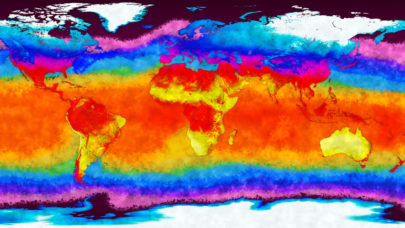
ORNL Debuts Cumulus-2 Cluster for Climate Data
July 22, 2022
Amid the much-deserved fanfare for the exascale Frontier system at Oak Ridge National Laboratory (ORNL), the lab, in April, launched a much smaller, but more la Read more…

Nvidia Combines Modulus, Omniverse for Earth-2 and Other Digital Twins
March 22, 2022
An accurate digital twin can be a boon to scientific endeavors, from recreating individual buildings in a city to understand energy use to recreating the Earth’s climate system to understand the effects of policies on climate change. At GTC21, Nvidia made waves by announcing that its Modulus framework for physics-based ML models and its... Read more…

US to Triple Its Supercomputing Capacity for Weather and Climate with Two New Crays
February 20, 2020
The blizzard of news around the race for weather and climate supercomputing leadership continues. Just three days after the UK announced a £1.2 billion plan to build the world’s largest weather and climate supercomputer, the U.S. National Oceanic and Atmospheric Administration... Read more…

NOAA Updates Its Massive, Supercomputer-Generated Climate Dataset
January 15, 2020
As Australia burns, understanding and mitigating the climate crisis is more urgent than ever. Now, by leveraging the computing resources at the National Energy Research Scientific Computing Center (NERSC), the U.S. National Oceanic and Atmospheric Administration (NOAA) has updated its 20th Century Reanalysis Project (20CR) dataset... Read more…

Topology Can Help Us Find Patterns in Weather
December 6, 2018
Topology--the study of shapes--seems to be all the rage. You could even say that data has shape, and shape matters. Shapes are comfortable and familiar concepts, so it is intriguing to see that many applications are being recast to use topology. For instance, looking for weather and climate patterns. Read more…

WCRP’s New Strategic Plan for Climate Research Highlights the Importance of HPC
July 19, 2018
As climate modeling increasingly leverages exascale computing and researchers warn of an impending computing gap in climate research, the World Climate Research Programme (WCRP) is developing its new Strategic Plan – and high-performance computing is slated to play a critical role. Read more…

New Exascale System for Earth Simulation Introduced
April 23, 2018
After four years of development, the Energy Exascale Earth System Model (E3SM) will be unveiled today and released to the broader scientific community this mont Read more…

Deep Learning at 15 PFlops Enables Training for Extreme Weather Identification at Scale
March 19, 2018
Petaflop per second deep learning training performance on the NERSC (National Energy Research Scientific Computing Center) Cori supercomputer has given climate Read more…

- Click Here for More Headlines

Whitepaper
Transforming Industrial and Automotive Manufacturing
In this era, expansion in digital infrastructure capacity is inevitable. Parallel to this, climate change consciousness is also rising, making sustainability a mandatory part of the organization’s functioning. As computing workloads such as AI and HPC continue to surge, so does the energy consumption, posing environmental woes. IT departments within organizations have a crucial role in combating this challenge. They can significantly drive sustainable practices by influencing newer technologies and process adoption that aid in mitigating the effects of climate change.
While buying more sustainable IT solutions is an option, partnering with IT solutions providers, such and Lenovo and Intel, who are committed to sustainability and aiding customers in executing sustainability strategies is likely to be more impactful.
Learn how Lenovo and Intel, through their partnership, are strongly positioned to address this need with their innovations driving energy efficiency and environmental stewardship.
Download Now
Sponsored by Lenovo
Whitepaper
How Direct Liquid Cooling Improves Data Center Energy Efficiency
Data centers are experiencing increasing power consumption, space constraints and cooling demands due to the unprecedented computing power required by today’s chips and servers. HVAC cooling systems consume approximately 40% of a data center’s electricity. These systems traditionally use air conditioning, air handling and fans to cool the data center facility and IT equipment, ultimately resulting in high energy consumption and high carbon emissions. Data centers are moving to direct liquid cooled (DLC) systems to improve cooling efficiency thus lowering their PUE, operating expenses (OPEX) and carbon footprint.
This paper describes how CoolIT Systems (CoolIT) meets the need for improved energy efficiency in data centers and includes case studies that show how CoolIT’s DLC solutions improve energy efficiency, increase rack density, lower OPEX, and enable sustainability programs. CoolIT is the global market and innovation leader in scalable DLC solutions for the world’s most demanding computing environments. CoolIT’s end-to-end solutions meet the rising demand in cooling and the rising demand for energy efficiency.
Download Now
Sponsored by CoolIT
Advanced Scale Career Development & Workforce Enhancement Center
Featured Advanced Scale Jobs:
HPCwire Resource Library
HPCwire Product Showcase
© 2024 HPCwire. All Rights Reserved. A Tabor Communications Publication
HPCwire is a registered trademark of Tabor Communications, Inc. Use of this site is governed by our Terms of Use and Privacy Policy.
Reproduction in whole or in part in any form or medium without express written permission of Tabor Communications, Inc. is prohibited.
























